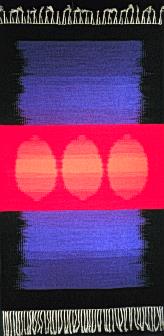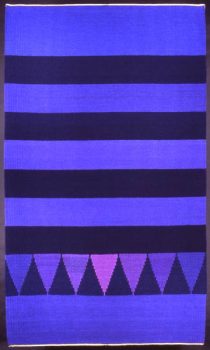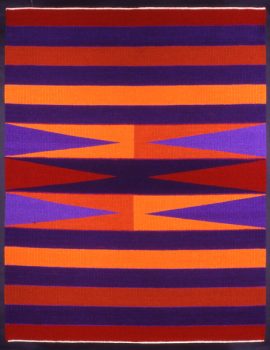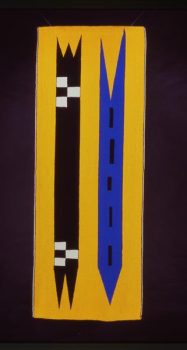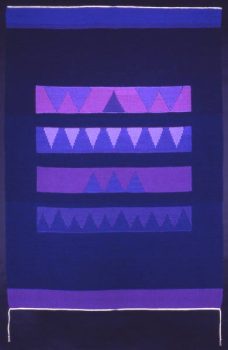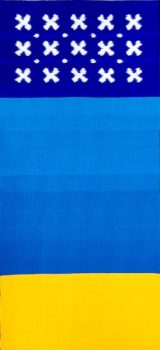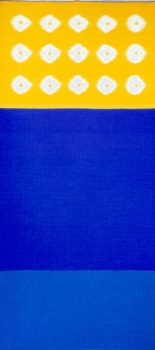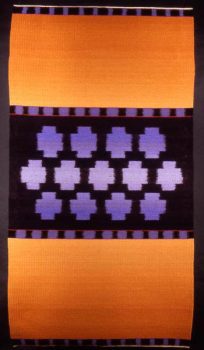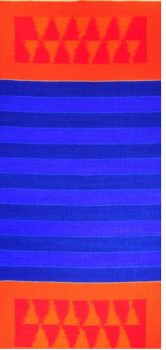

For over twenty-five years, award-winning textile artist Mary Zicafoose has been creating tapestries, rugs and prints that are as visually arresting as they are emotionally intense. She accomplishes this by reinterpreting centuries’ old weaving traditions into contemporary meditations on color and form that engage viewers in intimate dialogues between vibrant dyes and intricate patterns.
Largely self-taught, Zicafoose was initially inspired as a child when a favorite aunt gave her a scrap of Pacific Island fabric. For her, that scrap represented “a most magical form of cloth,” a textile that was more about narrative art than utilitarian object.
Although she went on to study art through more traditionally formal media such as painting and printmaking, Zicafoose returned to her earlier fascination with traditional ethic textiles and today creates work based on archetypal textile symbols steeped in tradition and saturated with rich colors.
Zicafoose’s work, however, is not just an iterative rendering of traditional weavings. The artist takes inspiration from modern abstractionists, and one can see the influence of painters such as Mark Rothko in her signature large, bold color fields. Her seemingly effortless blending of the ancient and the here and now results in textiles that span centuries of artistic tradition and situates them squarely within the contemporary visual lexicon. In this regard, Zicafoose is not “just” a weaver; rather she is a textile artist who uses fiber as her medium and a flat woven surface as her canvas.
The artist begins each of her woven series with dozens of small, hand-colored drawings, which serve as the basis for her pictorial series. She creates her tapestries and rugs, each of which is an original, signed and single edition, using a complex technique of resist dyeing and over-dyeing fibers called “Ikat.” This technique is highly important not just because it allows her to weave intricate patterns, but also because of what this ancient weaving method symbolizes. Ikat means to “bind” or “tie” in the Malaysian language, and binding is precisely what Zicafoose hopes to investigate: the infinite, intricate and repetitive ways through which cultures, rituals and collective memories bind us together.
In her artist statement, she explains: By evolving and transforming timeless motifs and visual language into a contemporary (con)text, I seek to engage my viewers – as well as myself – in dialogues and discussions that reawaken and tie us all to one another.
Time, too, is also of “the essence” of her work – or rather, timelessness. Weaving, of course, dates back millennia, but the process is in many ways beyond time. This is because there is no way to rush a tapestry. Zicafoose sits behind her loom and leaves time behind, patiently working hour after hour, week after week, at a steady, disciplined and highly meditative pace.
Ultimately, Zicafoose takes the complexity of warp and weft and archetypal symbols and combines them with her signature alchemical color schemes and carefully composed patterns to create singular tapestries that are about the texture of life – a “most magical form of cloth” indeed.
Mary Zicafoose has shown her work extensively in both solo and group shows at private galleries and venues like the San Jose Quilt & Textile Museum in San Jose, CA, the American Textile History Museum in Lowell, MA and the Phippen Art Museum in Prescott, AZ. Her tapestries have been included in leading textile events such as the American Tapestry Biennials #7 and #8 and the 13th International Triennial of Tapestry in Lodz, Poland.
She is a frequent keynote speaker, workshop leader and exhibition chair at international textile events such as the Midwest Weavers Conference, the Textile Society of America Symposium and the Convergence International Weavers Conferences, and her work has been covered by numerous publications, including: American Craft, FiberArts, Smithsonian Magazine, the Omaha World Herald, Handwoven Magazine, Shuttle Spindle & Dyepot and the Washington Post. Zicafoose’s tapestries, rugs and prints are featured in both private and public collections internationally, among which are Mobil Corporation, Norwest Banks and Tenaska Power Services.
An active presence in the textile world, she is co-director of the American Tapestry Alliance and a board member of GoodWeave USA (formerly RugMark).
As part of the Art in Embassies program, Zicafoose’s work is/has been featured in the following US Embassy permanent and lending collections, many of which are located in countries with strong weaving traditions: Baku, Azerbaijan Bandar Seri Begawan, Brunei Bangui, Central African Republic Quito, Ecuador Accra, Ghana Jakarta, Indonesia Almaty, Kazakhstan Vilnius, Lithuania Bangkok, Thailand Colombo, Sri Lanka Sanaa, Yemen.
Zicafoose runs a one-woman fiber studio in Omaha, Nebraska where she lives with her family.
Website
http://www.maryzicafoose.com
